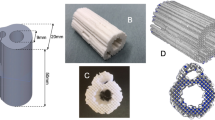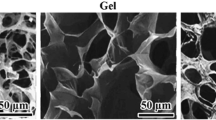Abstract
The aim of this study was to investigate the effectiveness of a novel hydroxyapatite containing gelatin scaffold—with and without local vascular endothelial growth factor (VEGF) administration—as the synthetic graft material in treatment of critical-sized bone defects. An experimental nonunion model was established by creating critical-sized (10 mm. in length) bone defects in the proximal tibiae of 30 skeletally mature New Zealand white rabbits. Following tibial intramedullary fixation, the rabbits were grouped into three: The defects were left empty in the first (control) group, the defects were grafted with synthetic scaffolds in the second group, and synthetic scaffolds loaded with VEGF were administered at bone defects in the third group. Five rabbits in each group were killed on 6th and 12th weeks, and new bone growth was assessed radiologically, histologically and with dual-energy X-ray absorptiometry (DEXA). At 6 weeks, VEGF-administered group had significantly better scores than the other two groups. The second group also had significantly better scores than the control group. At 12 weeks, while no significant difference was noted between the second and third groups, these two groups both had significantly better scores in all criteria compared with the control group. There were no signs of complete fracture healing in the control group. The administration of hydroxyapatite containing gelatin scaffold yielded favorable results in grafting the critical-sized bone defects in this experimental model. The local administration of VEGF on the graft had a positive effect in the early phase of fracture healing.





Similar content being viewed by others
References
Giannoudis PV, Dinopoulos H, Tsiridis E (2005) Bone substitutes: an update. Injury 36S(3):20–27
Roberts SJ, Howard D, Buttery LD, Shakesheff KM (2008) Clinical applications of musculoskeletal tissue engineering. Br Med Bull 86:7–22
Bolgen N, Plieva F, Galaev IY, Mattiasson B, Piskin E (2007) “Cryogelation” for preparation of novel biodegradable tissue engineering scaffolds. J Biomater Sci Polymer Ed 18(9):1165–1179
Glowacki J (1998) Angiogenesis in fracture repair. Clin Orthop (355S):82–89
Strydom DJ (1998) The angiogenins. Cell Mol Life Sci 54(8):811–824
Street J, Bao M, deGuzman L, Bunting S, Peale FV Jr, Ferrara N et al (2002) Vascular endothelial growth factor stimulates bone repair by promoting angiogenesis and bone turnover. Proc Natl Acad Sci USA 99(15):9656–9661
Eckardt H, Ding M, Lind M, Hansen ES, Christensen KS, Hvid I (2005) Recombinant human vascular endothelial growth factor enhances bone healing in an experimental nonunion model. J Bone Joint Surg Br 87(10):1434–1438
Maia J, Ferreira L, Carvalho R, Ramos MA, Gil MH (2005) Synthesis and characterization of new injectable and degradable dextran-based hydrogels. Polymer 46(23):9604–9614
Inci I, Kirsebom H, Galaev IG, Mattiasson B, Piskin E (2012) Gelatin cryogels crosslinked with oxidized dextran and containing freshly formed hydroxyapatite as potential bone tissue engineering scaffolds. J Tissue Eng Regen Med. doi:10.1002/term1464 [Epub ahead of print]
Cook SD, Baffes GC, Wolfe MW, Sampath TK, Rueger DC (1994) Recombinant human bone morphogenic protein-7 induces healing in a canine long-bone segmental defect model. Clin Orthop (301):302–312
Patel ZS, Young S, Tabata Y, Jansen JA, Wong ME, Mikos AG (2008) Dual delivery of an angiogenic and an osteogenic growth factor for bone regeneration in a critical size defect model. Bone 43(5):931–940
Giannoudis PV, Einhorn TA, Marsh D (2007) Fracture healing: the diamond concept. Injury (38S):3–6
Tsiridis E, Upadhyay N, Giannoudis P (2007) Molecular aspects of fracture healing: which are the important molecules? Injury (38S):11–25
Keramaris NC, Calori GM, Nikolaou VS, Schemitsch EH, Giannoudis PV (2008) Fracture vascularity and bone healing: a systematic review of the role of VEGF. Injury (39S):45–57
Beamer B, Hettrich C, Lane J (2009) Vascular endothelial growth factor: an essential component of angiogenesis and fracture healing. HSS J (9) [Epub ahead of print]
Augustin G, Antabak A, Davila S (2007) The periosteum. Part 1: anatomy, histology and molecular biology. Injury 38(10):1115–1130
Gerber HP, Vu TH, Ryan AM (1999) VEGF couples hypertrophic cartilage remodeling, ossification and angiogenesis during endochondral bone formation. Nat Med 5(6):623–628
Dimitriou R, Tsiridis E, Carr I, Simpson H, Giannoudis PV (2006) The role of inhibitory molecules in fracture healing. Injury (37S):20–29
Kleinheinz J, Stratmann U, Joos U, Wiessman HP (2005) VEGF-activated angiogenesis during bone regeneration. J Oral Maxillofac Surg 63(9):1310–1316
Tripathi A, Kumar A (2011) Multi-featured macroporous agarose-alginate cryogel: synthesis and characterization for bioengineering applications. Macromol Biosci 11(1):22–35
Liu Y, Lu Y, Tian X, Cui G, Zhao Y, Yang Q et al (2009) Segmental bone regeneration using an rhBMP-2-loaded gelatin/nanohydroxyapatite/fibrin scaffold in a rabbit model. Biomaterials 30(31):6276–6285
Ichinohe N, Kuboki Y, Tabata Y (2008) Bone regeneration using titanium nonwoven fabrics combined with fgf-2 release from gelatin hydrogel microspheres in rabbit skull defects. Tissue Eng Part A 14(10):1663–1671
Acknowledgments
This experimental research was performed in Gazi University Medical School, Animal Experiments Laboratory and was funded by Gazi University, Department of Scientific Research Projects with the project number SBE-1/2009/47.
Conflict of interest
No benefits in any form have been or will be received from a commercial party related directly or indirectly to the subject of this manuscript.
Author information
Authors and Affiliations
Corresponding author
Additional information
Disclaimer: We hereby state that all ethical, legal and animal rights wise considerations were fulfilled during and after this study.
Rights and permissions
About this article
Cite this article
Ozturk, B.Y., Inci, I., Egri, S. et al. The treatment of segmental bone defects in rabbit tibiae with vascular endothelial growth factor (VEGF)-loaded gelatin/hydroxyapatite “cryogel” scaffold. Eur J Orthop Surg Traumatol 23, 767–774 (2013). https://doi.org/10.1007/s00590-012-1070-4
Received:
Accepted:
Published:
Issue Date:
DOI: https://doi.org/10.1007/s00590-012-1070-4




